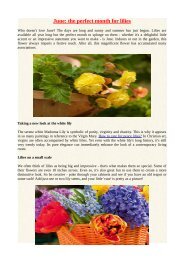Wild tulips
You also want an ePaper? Increase the reach of your titles
YUMPU automatically turns print PDFs into web optimized ePapers that Google loves.
<strong>Wild</strong> <strong>tulips</strong><br />
In addition to the large cultivated <strong>tulips</strong>, there are also what are known as ‘botanical <strong>tulips</strong>’. These<br />
<strong>tulips</strong> are particularly suitable for garden planting since they can remain undisturbed in the soil after<br />
flowering and will emerge again next year!<br />
Botanical <strong>tulips</strong> are also referred to as ‘wild <strong>tulips</strong>’ or ‘dwarf <strong>tulips</strong>’ due to their low height. Their<br />
height is one of the factors that makes them perfect for planting in a flower bed as well as in rock<br />
gardens and special little spots. With so many different varieties to choose from, they can create a<br />
real riot of colour in the garden or even in flower containers.
Over the years, botanical tulip varieties have often been awarded the ‘flower bulb of the year’ title.<br />
This says a lot about their rising popularity! The sizes of these bulbs are 6 to 10 cm. Smaller than<br />
most wholesale tulip bulbs but their numbers will easily increase year after year. Botanical <strong>tulips</strong> are<br />
not just exceptionally beautiful flowers in their own right but can also be combined with other<br />
spring-blooming flowers.<br />
These stunning <strong>tulips</strong> should be planted in the autumn garden and how to grow your tulip Choose a<br />
sunny spot for them, and you will be enjoying their profusion of flowers from April to June. You<br />
can also leave them undisturbed and they will pop up again the following year for another<br />
wonderful display.

















